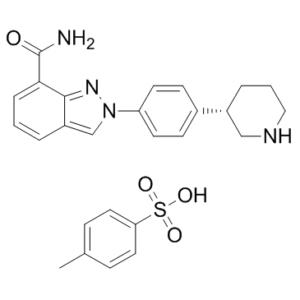This product is for research use only, not for human use. We do not sell to patients.

| Size | Price | Stock |
|---|---|---|
| 250mg | $350 | In Stock |
| 500mg | $500 | In Stock |
| 1g | $750 | In Stock |
Cat #: V3043 CAS #: 1038915-73-9 Purity ≥ 98%
Description: Niraparib Tosylate (also known as MK-4827; MK4827; Zejula), the tosylate salt of niraparib, is an orally bioavailable and selective inhibitor of PARP1/2 (IC50 = 3.8 nM and 2.1nM) that gained FDA approval in March 2017 for the treatment of recurrent epithelial ovarian, fallopian tube, or primary peritoneal cancer.
Publications Citing InvivoChem Products
Product Promise

- Physicochemical and Storage Information
- Protocol
- Related Biological Data
- Stock Solution Preparation
- Quality Control Documentation
| Molecular Weight (MW) | 492.59 |
|---|---|
| Molecular Formula | C26H28N4O4S |
| CAS No. | 1038915-73-9 |
| Storage | -20℃ for 3 years in powder formr |
| -80℃ for 2 years in solvent | |
| Solubility In Vitro | DMSO: ~500mg/mLr |
| Water: <1mg/mLr | |
| Ethanol: <1mg/mL | |
| Synonyms | MK-4827 tosylate; MK 4827; MK4827 tosylate; MK 4827 tosylate; MK-4827; MK4827; Niraparib; Niraparib HCl; Niraparib hydrochloride; Zejula Chemical Name: (S)-2-(4-(piperidin-3-yl)phenyl)-2H-indazole-7-carboxamide hydrochloride Exact Mass: 356.1404 |
| Protocol | In Vitro | Niraparib (MK-4827) inhibits PARP activity with EC50=4 nM and EC90=45 nM in a whole cell assay. MK-4827 inhibits proliferation of cancer cells with mutant BRCA-1 and BRCA-2 with CC50 in the 10−100 nM range. MK-4827 displays excellent PARP 1 and 2 inhibition with IC50=3.8 and 2.1 nM, respectively, and in a whole cell assay |
|---|
| Solvent volume to be added | Mass (the weight of a compound) | |||
|---|---|---|---|---|
| Mother liquor concentration | 1mg | 5mg | 10mg | 20mg |
| 1mM | 2.0301 mL | 10.1504 mL | 20.3009 mL | 40.6017 mL |
| 5mM | 0.4060 mL | 2.0301 mL | 4.0602 mL | 8.1203 mL |
| 10mM | 0.2030 mL | 1.0150 mL | 2.0301 mL | 4.0602 mL |
| 20mM | 0.1015 mL | 0.5075 mL | 1.0150 mL | 2.0301 mL |
This equation is commonly abbreviated as: C1 V1 = C2 V2
- (1) Please be sure that the solution is clear before the addition of next solvent. Dissolution methods like vortex, ultrasound or warming and heat may be used to aid dissolving.
- (2) Be sure to add the solvent(s) in order.




































